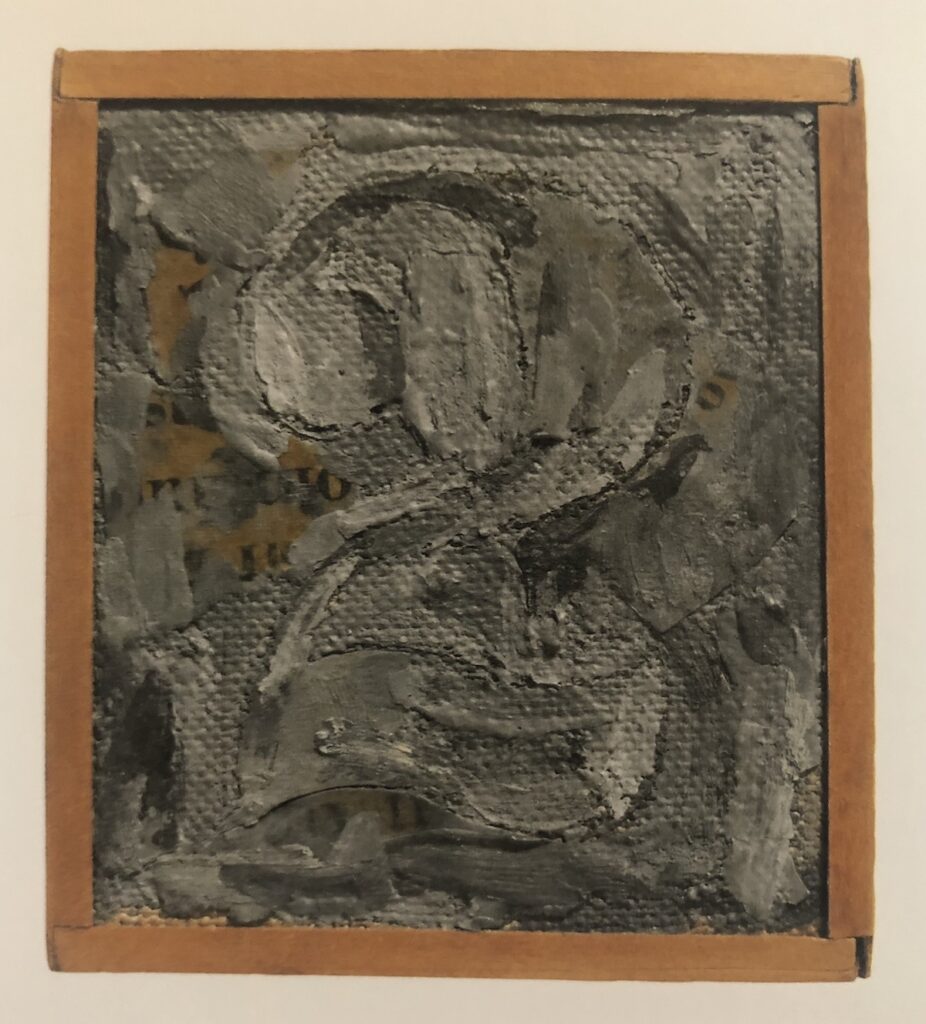
I went to the Philadelphia Museum today to see the Jasper Johns exhibition before it closes. There’s a lot to like, and a few things to love. The absolute winner for me was a little painting, rarely shown, which Johns has kept for himself since making it in 1959. Small Numbers In Color is extraordinary, one of two superlative works in the gallery devoted to Johns’ use of numbers.
It’s small, around 10 x 7 inches, and painted in encaustic on wood. The catalogue raisonné (P74, btw) says the wood is “the reverse side of a printer’s block with metal type.” [Which, a block would have cast metal affixed in a permanent way. A case would hold the sorted metal type, and a frame would hold type that has been set. Even though the metal type is not listed as part of the work, it does make me wonder what it says. Or looks like.]
None of that is evident from looking at the front; all you see is a tiny riot of color with an over-all grid, and then, the shapes of individual numbers coalescing into a whole. It looks to me like it replicates the basic color composition of Numbers In Color, a large (67 x 49.5 in.) painting from 1958-59 which went into the Albright Knox Museum collection soon after it was completed. Given the CR chronology (P58 vs P74), Small Numbers is presumably a documentation, or a memorialization, of Numbers, maybe made before the large painting shipped off to Buffalo. [In Roberta Bernstein’s 1975 dissertation that was the first published catalogue of all Johns’ paintings & sculpture to that point, Numbers in Color comes first in the 1959 works list, and Small Numbers comes almost at the end.] Who knows? There is almost no discussion of the work online. Actually, Johns Friend Craig Starr might know; the last time it was exhibited publicly was at the inaugural show of his gallery, in 2004.

The other standout from the same gallery is even smaller. Figure 3 (P84), from 1960, is Johns’ only double-sided painting. The 9×6 painting is framed so that both sides are visible. The verso is an approximation of the front, reversed, as if it were painted on a transparent ground, not canvas. The precise-enough brushstrokes of the back make their simulating point in the same way Small Numbers echoes Numbers.

Which is interesting, but is only a part of the fascinating intimacy of the very small artworks Johns created (creates?). The Whitney had a whole gallery of them, miniature examples of some of Johns’ most relevant motifs. In addition to the tiny silk flag encased in wax Johns made for Merce Cunningham, barely the size of a credit card, my favorite was the 3-inch encaustic Figure 2 (1959) made for Astrid and David Myers to celebrate the birth of their second child.

Besides the major concerns of Johns’ practice, these instantly recognizable works come with bonus content–like 2 for the second–and bonus context, marking the artist’s social network, his community of supporters and interlocutors. [Philadelphia has a vitrine filled with small artworks he received as gifts from Japanese contemporary artists he met while visiting in 1964. The so-called “hermit of Sharon” in fact trades art with his colleagues, and makes art for his friends.]
Part of the appeal of these works is that they exist outside the market–or at least they were created and first exchanged that way. Their miniature size is still determined by the market, though; even by the end of 1958, it would feel a bit much for someone to give a full-scale, “real” [sic] artwork, one that could be seen as having “real” market value. [Or worse, one that doesn’t, in which case, you’re assuming and asking a lot if you give a whole-ass painting to someone as a gift.] So they have to function on an emotional, personal level, as a gift, a gesture, but also as something the mind already knows–in this case, a Johns painting.
And of course, like the question, “Is it a flag or a painting of a flag?” these gift works are both gifts and works: Figure 2 has traded hands seven times and been auctioned twice since little Coco Myers turned 18.
